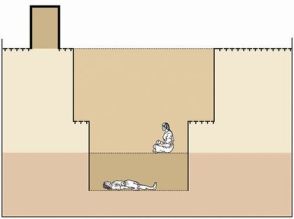Over the past few weeks there have been numerous articles and press releases regarding a tomb found in Peru. Each week it seems they find out something new and interesting about this site. The tomb is located on the Pacific Coast of Peru, about 13 miles inland near the modern city of Chiclayo. It is associated with the Lambayeque or Sicán culture, and is dated to the later period, approximately 1200-1350 CE. The find was part of the Chotuna-Chornancap archaeological project, and is being run by Carlos Wester La Torre, head of the excavation and director of the Brüning National Archaeological Museum. Since the discovery of the tomb almost 6 months ago, it has continued to reveal amazing finds including a priestess and a possible relationship to a rain deity.
The Lambayeque culture (named for the region they were located in) is also known as the Sicán culture (the name given by Izumi Shimada, a Lambayeque expert at Southern Illinois University), and dates approximately from 800 to 1375 CE. Little is known about the beginnings of the culture due to a lack of artifacts, and it is debated as to whether they replaced the Moche or are their descendants. They are most well known for their highly polished black finish ceramics and metalworking (primarily arsenical copper). Stylistically, there art and designs are an amalgamation of Moche and Wari: highly anthropomorphic, primarily avian or cosmological. Based on mortuary sites, it is inferred that they were a highly stratified society, with a number of levels of nobility. Elite burials are primarily found in deep shaft tombs, often the remains are found in a seated position and there are a variety of associated exotic grave goods.
At the Chotuna-Chornancap tomb site, archaeologists uncovered the remains of a young adult female, approximately 25 to 30 years old. She was buried with an impressive range of artifacts, including shells, gold, ceramics, and ceremonial objects that would have been traded over long distances. She was also found with a golden sceptre that had the image of a Lambayeque divinity; thought to be a symbol of the prominence she had during her life. Her body was found in a seated position, also suggestive of her high status (I discuss elite Sican burial practices in an earlier article here)Also within the tomb were the remains of eight other individuals thought to be accompanying her into the afterlife. It is thought that she was a priestess based on knowledge of inscriptions and the period that suggest during the final period of this culture it was more common for females to hold high status religious roles.
As the dig continued, they found that the tomb itself was uniquely constructed and may have even been built for flooding. The lower level of this tomb, which contains the remains of four individuals and numerous shells, is actually below the water table. This means that it is flooded. The lower submerged burial also contains remains of an individual thought to be of higher status, with an entourage of three for the afterlife. The archaeologist argue that the burial in a waterlogged section would have been intentional. At the beginning of this late period there were major droughts, so there is a correlating rise in the presence of religious artifacts relating to water and ocean gods. Burial within this flooded tomb may have been related to rebirth or renewal during this period of drought.
It is important to note that we do not know what the water table was like during this period, and given that they were experiencing a drought it may just be coincidence that a tomb with water based iconography became flooded over the past 800 years. Throughout the articles, Shimada notes that we don’t know too much about the burial culture of the elite Sican people. Few tombs have been recovered, so it is difficult to know which practices are unique, which are standard, and which are not actually on purpose (such as the flooding). As more work is done to identify the remains of individuals at this site, and work continues on Sican sites, we may be able to understand what was considered normal and what these tombs meant to the culture who created them.
Works Cited
AP. 2012. Remains of Priestess Found. Hispanically Speaking News. http://www.hispanicallyspeakingnews.com/notitas-de-noticias/details/remains-of-priestess-of-the-13th-century-lambayeque-culture-found-in-peru/15191/



A fascinating post Kate. Thanks for sharing
Pingback: DNA tests to unravel mystery of Peruvian priestess and burial companions | Travelleak·